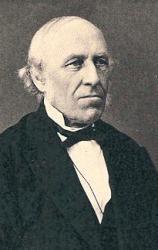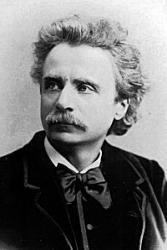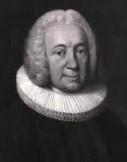Planning worship?
Check out our sister site, ZeteoSearch.org,
for 20+ additional resources related to your search.
- |
User Links
Search Results
Den store hvide Flok, vi se
Author: Hans Adolf Brorson Appears in 8 hymnals
Den store hvide Flok, vi se
[Den store hvide Flok, vi se]
Appears in 1 hymnal Composer and/or Arranger: Ludv. M. Lindeman Tune Key: C Major Incipit: 51176 55334 45235 Used With Text: Den store hvide Flok, vi se
[Den store hvide Flok, vi se]
[Den store, hvide flok vi se]
Appears in 30 hymnals Composer and/or Arranger: Grieg Tune Key: F Major Incipit: 13556 53135 22342 Used With Text: Den store, hvide Flok
[Den store, hvide flok vi se]
Den store hvide Flok, vi se
Author: H. A. Brorson Hymnal: M. B. Landstads Kirkesalmebog og "Nokre Salmar" ved Professor Dr. E. Blix, samt følgende tillæg #559 (1897) Lyrics: 1 Den store hvide Flok vi se,
Som tusind Bjerge fuld' af Sne,
Med Skov omkring af Palmesving,
For Thronen. Hvo er de?
Det er din Helteskare, som
Af hin den store Trængsel kom,
Og har sig toed i Lammets Blod,
Til Himlens Helligdom.
Der holde de nu Kirkegang
Med uophørlig Jubelklang
I høie Kor, hvor Gud han bor,
Blandt alle Englers Sang.
2 Her gik de under stor Foragt,
Men se dem nu i deres Pragt
For Thronen staa med Kroner paa
I Himlens Præstedragt!
Sandt er det, i saa mangen Nød
Tidt Taarestrøm paa Kinden flød,
Men Gud har dem, straks de kom hjem,
Aftørret paa sit Skjød.
Nu holde de, og har tilbedst'
Hos ham en evig Løvsals-Fest,
Og Lammet selv ved Livets Elv
Er baade Vert og Gjest.
3 Til Lykke, Kjæmpe-Samling! ja,
O tusindfold til Lykke da,
At du var her saa tro især,
Og slap saa vel herfra!
Du har foragtet Verdens Trøst,
Saa lev nu evig vel, o høst,
Hvad du har saad med Suk og Graad,
I tusind Engle-Lyst!
Ophøie din Røst, slaa Palme-Takt,
Og syng af Himmel-Kraft og Magt:
Pris være dig evindelig,
Vor Gud og Lammet, sagt! Topics: Alle Helgens Dag Til Aftensang; All Saints Day Evening; Reformationsfest; Reformation Celebration; God's Call; Guds Kald; Første Søndag i Advent Til Aftensang; First Sunday in Advent For Evening; Mariæ Bebudelses Dag Til Aftensang; Annunciation For Evening; Alle Helgens Dag Til Aftensang; All Saints Day For Evening; 26 Søndag efter Trefoldigheds Fest Til Hoimesse; Twenty-sixth Sunday after Trinity Sunday High Mass Languages: Norwegian Tune Title: [Den store hvide Flok, vi se]
Den store hvide Flok, vi se
Den store, hvide Flok
Hymnal: Evangeli harpe #K10 (1906) First Line: Den store, hvide flok vi se Languages: Norwegian Tune Title: [Den store, hvide flok vi se]
Den store, hvide Flok
Den store hvide Flok, vi se
Hymnal: Psalmebog, udgiven af Synoden for den norske evangelisk-lutherske Kirke i Amerika (2nd ed.) #381 (1890) Lyrics: 1 Den store hvide Flok, vi se
Som tusind Bjerge fuld' af Sne,
Med Skov omkring af Palmesving,
For Thronen. Hvo er de?
Det er din Helteskare, som
Af hin den store Trængsel kom,
Og har sig to'd i Lammets Blod,
Til Himlens Helligdom.
Der holde de nu Kirkegang
Med nophørlig Jubelklang
I høie Chor, hvor gud han bor,
Blandt alle Engles Sang.
2 Her gik de under stor Foragt,
Men se dem nu i deres Prag!
For Thronen staar de Slagtefaar
I Himlens Præstedragt.
Sandt er det, i saa mange Nød
Tidt Taarestrøm paa Kinden flød,
Men Gud har dem, strax de kom hjem,
Aftørret paa sit Skjød.
Nu holde de, og har til bedst'
Hos ham en evig Løvsals-Fest,
Og Lammet selv ved Livets Elv
Er baade Vert og Gjæst.
3 Til Lykke, Kjæmpesamling, ja,
O tusindfold til Lykke da,
At du var her saa tro især,
Og slap saa vel herfra!
Du har foragtet Verdens Trøst,
Saa lev nu evig vel, o høst,
Hvad du har saa't med Suk og Graad,
I tusind Englelyst!
Ophøi din Røst, slaa Palmetakt,
Og sjung af Himmelkraft og Magt:
Pris være dig evindelig,
Vor Gud, og Lammet sagt!
Topics: Allehelgensdag Aftensang; All Saints' Day Evening; Det evige Liv; Eternal Life Languages: Norwegian
Den store hvide Flok, vi se
Ludvig Mathias Lindeman

1812 - 1887 Person Name: Ludv. M. Lindeman Composer of "[Den store hvide Flok, vi se]" in M. B. Landstads Kirkesalmebog og "Nokre Salmar" ved Professor Dr. E. Blix, samt følgende tillæg Ludvig M. Lindeman (b. 1812; d. 1887) was a Norwegian composer and organist. Born in Trondheim, he studied theology in Oslo where he remained the rest of his life. In 1839 he succeeded his brother as the organist and cantor of Oslo Cathedral, a position he held for 48 years up until his death. Lindeman was appointed Knight of the Royal Norwegian Order of St. Olav, and was invited to both help christen the new organ in Royal Albert Hall in London, as well as compose for the coronation of King Oscar II and Queen Sophie of Sweden. In 1883, he and his son started the Organist School in Oslo. Lindeman is perhaps best known for his arrangements of Norwegiam folk tales; over the course of his life he collected over 3000 folk melodies and tunes.
Laura de Jong
Ludvig Mathias Lindeman
Edvard Grieg

1843 - 1907 Person Name: Grieg Arranger of "[Den store, hvide flok vi se]" in Evangeli harpe Edvard Hagerup Grieg Born at Bergen, Norway, of Scottish descent, son of a merchant and vice-consul in Bergen, his mother was a music teacher. He became a pianist and composer, with his standard classical repertoire known worldwide. He developed Norwegian folk music into his own compositions, helping to develop a national musical identity. As a child his mother taught him piano from age six. He attended several schools. His uncle, a Norwegian violinist, recognized his nephew’s talents at age 15 and urged his parents to send him to the Leigzig Conservatory in Germany. He enrolled there and concentrated on piano. He enjoyed the many concerts and recitals given in Leipzig. He disliked the discipline of the conservatory course of study, but he loved the organ, mandatory for piano students. In 1860 he survived a life-threatening lung disease, pleurisy and tuberculosis. Throughout life, his health was impaired by a destroyed left lung and disformity of his thoracic spine. He suffered numerous respiratory infections, and ultimately developed combined heart and lung failure. He was admitted many times for various spas and sanatoria in both Norway and abroad. Several of his doctors became close friends. In 1861 he made his debut as a concert pianist at Karlshamm, Sweden. He finished Leipzig studies in 1862 and held a concert in his hometown, playing Beethoven’s ‘Pathetique’ sonata. In 1863 he went to Copenhagen, Denmark, remaining there three years. There he met Danish composers and a fellow Norwegian composer, Rikard Nordraak, who wrote the Norwegian National Anthem. When Nordraak died in 1866, Grieg composed a funeral march in his honor. In 1867 Grieg married his first cousin, Nina Hagerup. Their only child, Alexandra, was born the following year. She died from meningitis at age two. In 1868 he wrote his Piano Concerto in A-minor. It was performed by Edmund Nuepert in Copenhagen because Grieg was in Norway at the time, fulfilling other commitments. In 1868 Franz Liszt, not yet having met Grieg, wrote a testimonial of him, resulting in Grieg’s obtaining a travel grant. The two met in Rome in 1870. Each was impressed with the other’s musical accomplishments. Grieg had close ties with the Bergen Philharmonic Orchestra and became its leader 1880-1882. In 1888 Grieg met Tchaikovsky in Leipzig. He was struck by Tchaikovsky’s sadness. Tchaikovsky praised Grieg’s music. The Norwegian government awarded Grieg a pension. In 1903 he made gramophone recordings of his piano music in Paris, France. He also made live piano music rolls for the Hupfeld Phonola piano-player system and Weldt-Mignon reproducing system. He also worked with the Aeolian Company for its ‘Autograph Metro-style’ piano roll series, wherein he indicated the tempo mapping of many of his pieces. In 1906 he met pianist and composer, Percy Grainger, in London. Grainger was an admire of Grieg’s music, and they developed a strong empathy for each other. Grieg wrote of Grainger: “I have written Norwegian dances that no one in my country can play, and here comes this Australian who plays them as they ought to be played. He is a genius that we Scandinavians cannot do other than love.” Grieg and his wife considered themselves Unitarians, and attended that church denomination. When Grieg died after a long illness, at age 64, his funeral drew more than 30,000 people in his hometown, who came out to honor him. His own funeral march, in honor of Nordraak, was played, along with a 2nd march, by his friend, Johan Halvorsen, who married Grieg’s niece. Grieg was cremated, with ashes entombed in a mountain crypt. Later, his wife’s were placed with his.
John Perry
Edvard Grieg


 My Starred Hymns
My Starred Hymns



